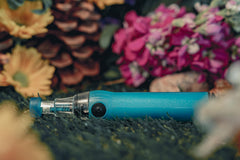Diabetes Travel Tips
Diabetes doesn’t limit your ability to travel freely to the destinations you dream of - it simply adds an extra layer of planning, preparation, and maintenance. Once you put foolproof processes in place to manage diabetes, however, you’ll forget it’s even there (as much as anyone can, at least). But what are those processes?

Nice to meet you, I’m David Kindness (aka @type1wild)! I’ve been carrying type 1 diabetes around for about 14 years now, and I’ve been a travel fanatic for as long as I can remember. I’m grateful to have traveled to something like 23 countries so far, and to have made outdoor adventures a big part of my life - mostly in the forms of adventure photography, hiking, backpacking, and rock climbing. Now for the big question: what are the best ways to travel with diabetes?

The 4 Laws of Traveling With Diabetes
- Insulin, insulin, insulin.
- Carbs, carbs, carbs.
- Pack multiple cold strategies.
- Understand your destination and its climate.
LAW 1: Insulin, Insulin, Insulin
The first rule of traveling with diabetes is to bring more than enough insulin. I generally bring about 50% more insulin than I think I’ll need, and the warmer the climate, the more of a buffer I give myself. This is because anything can happen - you can lose it, forget it on a plane, accidentally leave it in the heat for too long, or simply run out unexpectedly. Pack plenty of backups, and ideally, store them in separate bags to reduce the risk of losing them.
LAW 2: Carbs, Carbs, Carbs
This law is similar to the first - pack multiple forms of carbs, some of which you’ll ideally never even use. And be sure to pack carbs that can be used in heat without melting, in the cold without freezing, and in the rain without being soaked and ruined. Also understand how easily you’ll be able to purchase new carbs in your destination - are there shops? Bars? Gas stations? Here’s a sneaky tip: take sugar packets from coffee shops and keep them in a plastic bag as an always-refillable backup.
LAW 3: Pack Multiple Cold Strategies
As I’m sure you know, insulins of all kinds can get denatured (stop working) when they’re too hot. According to Healthline and the Cleveland Clinic, insulin can function in temps up to 86°f (30°c), and can safely reach temps of 93-95°f (34-35°c) for short periods of time. But ideally they stay cooler, so I always pack multiple cold strategies. I pack frio packs (water-activated cooling pouches) - a small one for daily use and a large one for backups. This is a really adaptable way to keep insulin cold, as it only needs water to work. I also usually pack an insulin cooler bottle (I use the ones from 4AllFamily) as another way to keep insulin cold - these rely on either a cold pack or plug-in cooling lid. To save space, they can also be used as water bottles (with the normal lid, not the electric one). There are also Frio packs for pumps, and Kaio-Dia also has water-activated cooling packs.
LAW 4: Understand Your Destination And Its Climate
This one is fairly simple. Understand your destination and its climate: What language do they speak? Is diabetes understood in their culture? Are there plenty of shops, grocery stores, etc? Will the places you’re staying have air conditioning and refrigerators? Do the cities and towns have public water? Are there lakes or rivers (for Frio packs)? Will it be hot or cold during the day and at night? You don’t need to memorize every tiny aspect of the destination, but having a general understanding will help you prepare appropriately.
Other Strategies Worth Noting
Doctor’s Notes: I’ve been on 1,000+ flights, and I’ve only been asked to prove I have T1D with a doctor’s note once. I said no, and they didn’t really care - they let me through anyways. But it may be worth bringing one in case the destination is less understanding of T1D or less welcoming of foreigners.
Pharma Laws: Research pharma laws in the destination. Unlike in the US (cough cough), insulin is relatively inexpensive in many parts of the world, and you might be able to walk into a pharmacy and buy it over-the-counter for around $30-$40.
Shipping Insulin: It may be worth planning for a way to ship insulin from home (overnight) in the event that you lose yours and can’t find more. Telling family or friends how to do it ahead of time and giving them a few pens can prepare them for this.
Match Insulin to Lifestyle: Be aware that insulin needs often change while traveling. If you’re walking or hiking a lot - especially in the heat - then you might need to use lower basal and bolus amounts, as your exertion will lower your blood sugars naturally. Using too much insulin could start the blood sugar roller coaster, and no one wants that!
Most Importantly: enjoy your freedom and your travels. Life is short, and diabetes is only a small part of it. Don’t forget to live your life to the fullest in spite of it.

Thank you David for your insights and tips on how to not let your diabetes hold you back from "Doing What You'll Wish You'd Done." All of the exquisite photos seen above were taken by David. Follow along with him on Instagram or you can help support his travels on Etsy or his Website.
Also by using code Type1Wild you can get 10% off your purchase of a Genteel Lancing Device.






1 comment
David Kindness
Aug 19, 2022 at 11:30So honored to be featured in your blog! Your team is amazing and I’m grateful for everything you do for the diatribe.